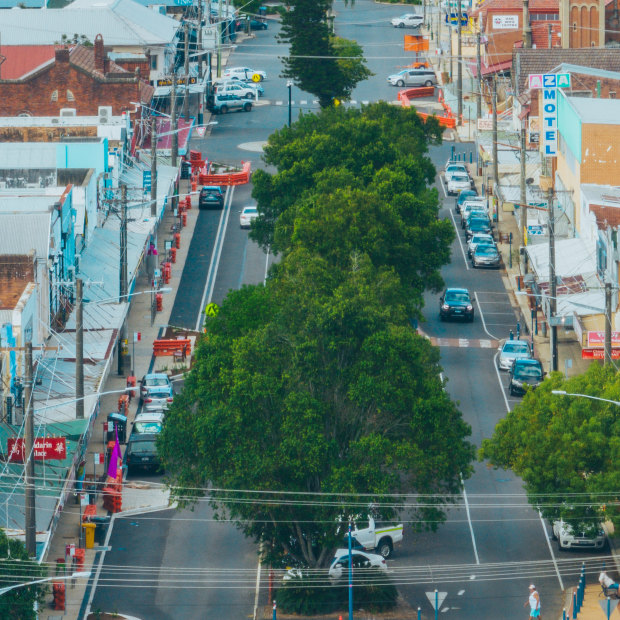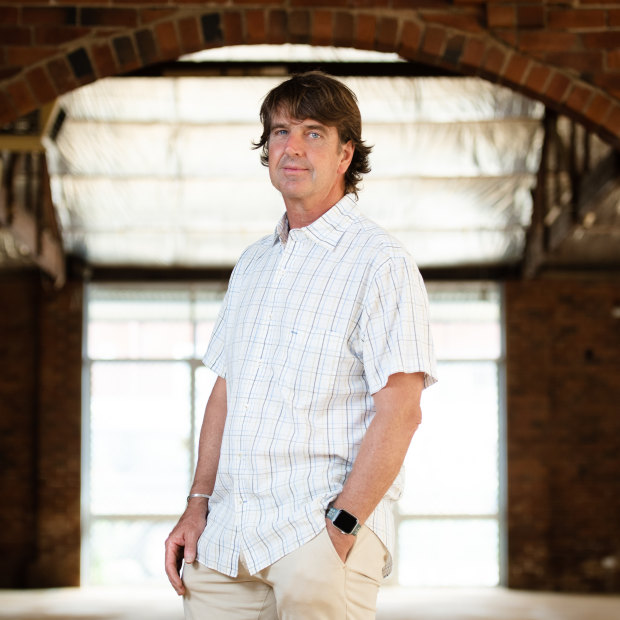‘Crazy brave’: the businesses taking on Australia’s flood capital
By Heath Gilmore
Keen Street in Lismore, a year after the floods.Credit:Angus Gray
They are the self-anointed mad punters: everyday people with dreams to make a mark in the business world. Only they have chosen Australia’s flood capital to do it.
Twelve months after one of our biggest natural disasters, the city centre of Lismore is a patchwork of activity and desolation. Some retailers are ebullient, some catatonic, and others shuttered their shops forever, leaving behind just the flies buzzing.
However, in this city without flood insurance, without reliable flood warnings, without any meaningful flood mitigation works under way, hope stirs.
CBD occupancy is now almost 60 per cent, which includes street-front and upstairs premises. Before the flood, it was hovering about 90 per cent. Six months after the flood it was 38.3 per cent.
Newcomers are opening businesses or buying cut-price buildings to join pre-existing retailers who literally dragged themselves out of the mud to start again.
It’s a big gamble in this town.
John Stewart is among those daring to dream big. The founder of the three-year-old Living School wants to open a new campus on one of Lismore’s high streets by August.
He joins the sole traders, business partnerships, companies, property trusts, government bodies and not-for-profit groups sinking serious money into the Lismore floodplain.
Dairy giant Norco is rebuilding its ice-cream factory on the banks of the Wilsons River. The co-operative will contribute $59 million to the project, with an additional $34.7 million and $11 million in federal and state government support. Stand-alone shopping centre Lismore Square revamped its devastated site and is almost back to full tenancy. Likewise, its smaller cousin Lismore Central is undergoing a $15 million overhaul that includes retractable escalators if any future flood threatens. Westlawn outlaid $2 million repairing its five-storey building that attracted new major tenant Social Futures, which brought 120 staff to the CBD.
John Stewart, from Lismore’s The Living School.Credit:Elise Derwin
Stewart, a former headmaster of Southern Highlands’ Tudor House, bought a dormant country department store, McLeans Brown and Jolly, just before the 2022 flood, intending to create a middle school for up to 160 fee-paying students from years 5 to 8.
After the disaster, however, Stewart and the school board debated for months whether to proceed with a staged $6 million regeneration of the 123-year-old building in Woodlark Street. They recommitted.
“I know what people are saying: mad John Stewart. I get the emails,” he says.
“We know there will be future floods. We have assessed the risk, and we feel the responsibility to go back into our heartland outweighs the risk.
“We want to be a major future hub of the Lismore community and help that community deal with its floods.
“Everyone is going to have issues because of climate change [across Australia]. We need to see Lismore as an opportunity, not to quickly abandon it, but to see how do we adapt and support it.”
Fifteen year 10 students will get apprenticeships to work on the rebuild. The multi-storey department store will be stripped back to concrete and hardwood timber with detachable waterproof cladding installed to allow easier cleaning, with lifts and hoists to raise equipment above the 2022 flood level. Part of the roof will be removed to bring sunlight into the building. An internal rainforest will be planted to assist with post-flood decontamination.
The school will be redesigned to accept floods entering and, just as importantly, leaving quickly.
They will have plenty of opportunity to test their plan.
Twenty-nine big floods — 9.9 metres or higher — have swamped downtown Lismore since 1870. After a 10.65-metre high levee was built in 2005, only three floods have entered the CBD. The 2022 disaster — a record 14.37 metres – was two metres above the previous biggest recorded events in 1954 and 1974.
Lismore is at the mercy of its European history, which from 1842 became a place to cut down precious cedar timber and farm dairy and beef cattle. A town based around the highest navigable port for cargo-carrying vessels on the north arm of the Richmond River, now called the Wilsons River.
The town took root around its river origins, growing outwards in fits and starts, governed by the whims of pastoralists and the surrounding valleys.
Modern Lismore is a regional city, a sprawl straddling two worlds. Half of its residents, most of its business, industry and civic buildings and cultural institutions are wedded to the historic river valley floor, 10 metres above sea level. The other half sits atop a plateau 130 metres to 170 metres above sea level, east of the central business district.
Its university and Base Hospital (out of the flood zone), its two major shopping centres, Lismore Square and Lismore Central, as well as regional government offices, white-collar professionals and most of its industrial estates (all on the floodplain) serve the entire Northern Rivers region of nearly 300,000 people.
Now, it is evolving again: Lismore is Australia’s first climate change city.
Lismore Mayor Steve Krieg knows the price extracted for doing business there. The 2022 disaster smashed him.
Before the flood, Krieg and wife Julianne owned two cafes, La Baracca and Ristretto, downtown. Both were leased properties. With three children, the couple lived in a house attached to La Baracca. They lost everything.
“It would have been very easy to walk away,” he says. “We had sold our family house to keep the businesses going after the 2017 flood, and we were saving for another home loan.
“We were eligible for business grants but also had to spend tens of thousands of dollars of our savings to get back.
“We shut down Ristretto but kept going with La Baracca. Given my position [as mayor], I couldn’t look this town in the eye if we walked away.”
Krieg admits, however, he was unable to sign another five-year lease for La Baracca and the attached house during recent renewal discussions. He didn’t have the confidence.
“This city is waiting for the final CSIRO report [due late next year] on long-term mitigation solutions and whether the NSW and federal governments will back protecting the CBD,” he says.
“We should be the test case for the rest of the nation … building back safer, smarter and sustainably.
“But, for now, we hold our breath.”
Cafe owner Bill Sheaffe, together with his wife Dr Ros Irwin and grandchildren, had held their breath long enough.
They closed Caddies, which had operated in the city centre for 30 years, and a coffee roastery in South Lismore. Sheaffe misses the business but has no regrets about their decision.
“People were always at their best when they go for a cup of coffee,” he says. “I really miss that … but we couldn’t afford to reopen [both businesses]. It would have cost us $200,000 to $250,000.
“I was devastated [by the flood] but the whole town was devastated. It pulled Lismore up with a stop.
“We’d been through nine floods before but nothing like that. I was near the end of my working career and was not going to saddle our family with that kind of debt.”
Chris Harley, the principal of Ray White Lismore, says commercial buildings have lost about 20 per cent in value across the region since the floods. The drop in downtown Lismore had been more substantial.
However, Harley says the market still hasn’t reset itself yet.
“We have seen a number of genuine businesses taking the punt and buying up property,” he says.
“But the other investors are quite clear they prefer not to be relying just on the weather gods. They want to know how much mitigation will lessen the likelihood of flooding or soften the blow.”
Elton Cummings’ family are long-time owners of three large CBD properties. He has consolidated his and pre-existing tenants into one building and is biding his time on the other Molesworth Street buildings until “the government makes some decisions”.
When asked what is going on in the Lismore CBD, he laughs uproariously.
“Mate, they are having a giant punt,” the 70-year-old says, “We all are, really.
“You’re banking on either the government coming up with a serious mitigation solution or a planning policy decision to build upwards where the first two floors are car parks or easily evacuated shops or no major flood for the next 10 years.
“If it comes off, your building’s value starts taking off and revenue’s flying.
“I wish I was 20 or 30 years younger. I’d love to buy two or three properties on the cheap. Look, it might not come off, and you need to be young enough to start all over again. But there’s a chance you’d be a multimillionaire.
“It’s a gamble … but gee, it would be fun.”
And he starts laughing again.
Most Viewed in National
Source: Read Full Article


